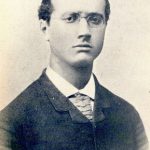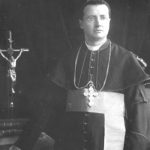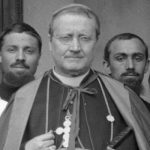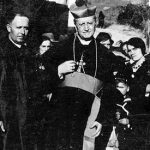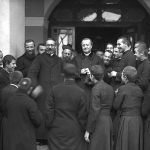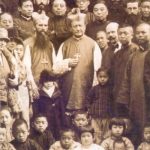The Life of our Founder
Legacy of our Founder | Celebrating his Legacy | The Circular Letters
Conforti: Early Years and Priestly Formation
Guido Conforti was the eighth of ten children of Rinaldo Conforti and Antonia Adorni. He was born on March 30, 1865 at Casalora di Ravadese, in the midst of a fertile land of Parma, Italy. All the educational efforts undertaken by his parents geared toward a specific goal, dreamed by his father: to have his son be the future administrator of the farm and its properties.Guido attended the school of the Christian Brothers in Parma, and he could have very well been a successful manager. On the way to school, Guido developed the habit to stop in prayer in front of a huge Crucifix in the Church of Peace. There was an intense conversation among the two of them: ‘I looked at Him, and He looked at me, and it seemed he was telling me many things’ Guido Conforti used to retell later when he became bishop. In that meeting with the Crucifix, Guido felt called to the priesthood.
The Cross: The Source of My Vocation
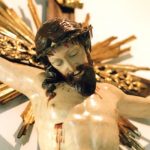 “I looked at him, and he looked at me, and it seemed as though he was telling me many things.”
“I looked at him, and he looked at me, and it seemed as though he was telling me many things.”
God revealed the fullness of his love in his Crucified Son. One day this love touched the heart of young Guido Conforti in an almost natural way. He was but a child. Every morning, he stopped at the “Church of Peace” to gaze at the large Crucifix there.
This was the beginning of an uninterrupted dialogue with Christ crucified. Later when he was sixty years old and bishop, his sister often found him rapt in ecstasy before that crucifix, which had been brought to his residence, at his request. Was it that dialogue with the Crucified Lord that sparked the idea to found a missionary congregation?
Archbishop of Ravenna, ready to do God’s will
In May of 1902, Conforti was named Bishop of Ravenna by Pope Leo XIII. It could have been a deadly blow to Conforti and his newly born congregation. In his conversation with the Pope, Conforti shared his dream of going to China, and the Pope told him that his field of work was Ravenna, “the China of Italy.” The Pope continued: “I summoned you to Rome in person so that you could hear from the mouth of the Pontiff himself what he asks of you. So be ready to do the will of God and He will give you the grace necessary for the fulfillment of His plan.”
On June 11th, 1902 at St. Paul Church outside the Walls in Rome, Guido was consecrated Bishop. He also made his religious profession together with the vow to dedicate himself without reserve to the proclamation of the Gospel “ad gentes.” This assignment proved to be a Way of the Cross.
Bishop of Parma, but Missionary to the World
“I find everywhere the holy enthusiasm to spread the Gospel”
The Love of God’s People, the hand of fate, or the inspiration of the Spirit was to again enter the life of Guido: in December of 1907, Guido became bishop of Parma, following the death of Bishop Magani. Bishop Conforti adopted In Omnibus Christi (Christ in all things) as his motto, and the Xaverian Missionaries would later adopt it as well. It was to be put to practical application in his pastoral visits throughout the diocese. For almost 25 years he was the good shepherd of his flock, a living sign of the maternal concern that the Church shows towards all, whether they belong to the Church or otherwise, paying special attention to the poor and the weakest among them.
As with Ravenna, religious instruction was the priority of his pastoral agenda: he founded schools of Christian doctrine in all parishes and prepared catechists with appropriate courses in pedagogical and religious culture. He was the first in Italy to celebrate a catechetical week.
The Love of God’s People
Bishop Conforti dedicated a lot of time in prayer, even though he was not a monk. In the serenity of that “nest of eagles,” as he used to call his community, and with the fresh air of his native Parma, he regained his strength. On September 16, 1907 Pope Pius X sent Conforti a letter, asking him to become collaborator of the dying bishop of Parma, Bishop Magani. The Pope began his letter with these words: “It’s two of us who are asking you this great favor, a service to be accepted at any cost and personal sacrifice.” It was a request from both the Pope and the Bishop of Parma, and Conforti accepted with the words “On the tomb of the Apostles, I now vow to die on the Cross.”
President of the Missionary Union of the Clergy
Bishop Conforti’s concern for the Church entrusted to him never distracted him from the “concern for those parts of the world where the Word of God had not yet been proclaimed.” He was convinced that the proclamation of the Gospel “ad gentes” (to the nations), was the most effective way of re-evangelizing his own people. He was untiring, therefore, in his commitment to mission evangelization and promotion, both through the work of his own missionary family, as well as supporting every missionary animation initiative in Italy and throughout the world.
Visit to China and Death of a Saint
One last significant event in Conforti’s life was his journey to China, which he undertook “as a duty and a need of my heart.” Notwithstanding his ability to deal with missionary problems as a founder of a missionary congregation and president of the Missionary Union of the Clergy, he recognized that this trip would help him appreciate more the mission service and dimension of the church.
China gave him a new sense of the vastness of its territory: “We don’t need 3,000 missionaries in China, but 50,000!… I’ll look forward to that day when the whole of China will be called a Christian nation!” Before leaving China, Bishop Conforti addressed his missionaries by saying, “I hope that my visit will bring great good, deepen our love, and give all of us greater encouragement to work willingly and constantly for the missions… I’m amazed at what you have accomplished for the good of these Chinese people. How I would like to be young again, and dedicate all my energies to them!”
